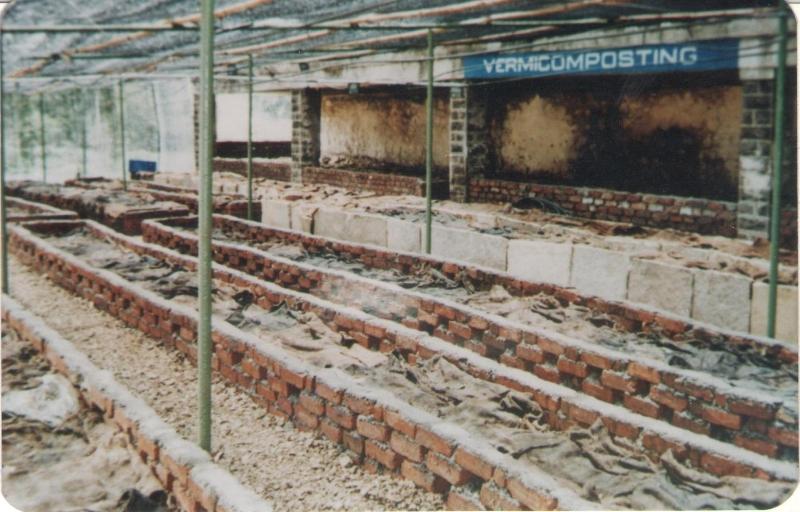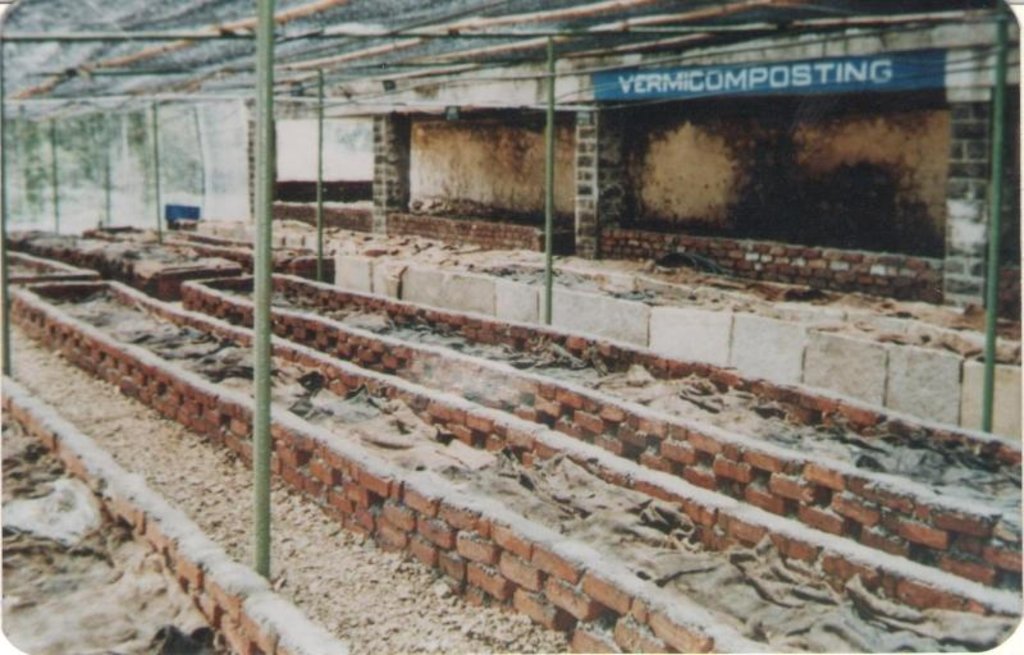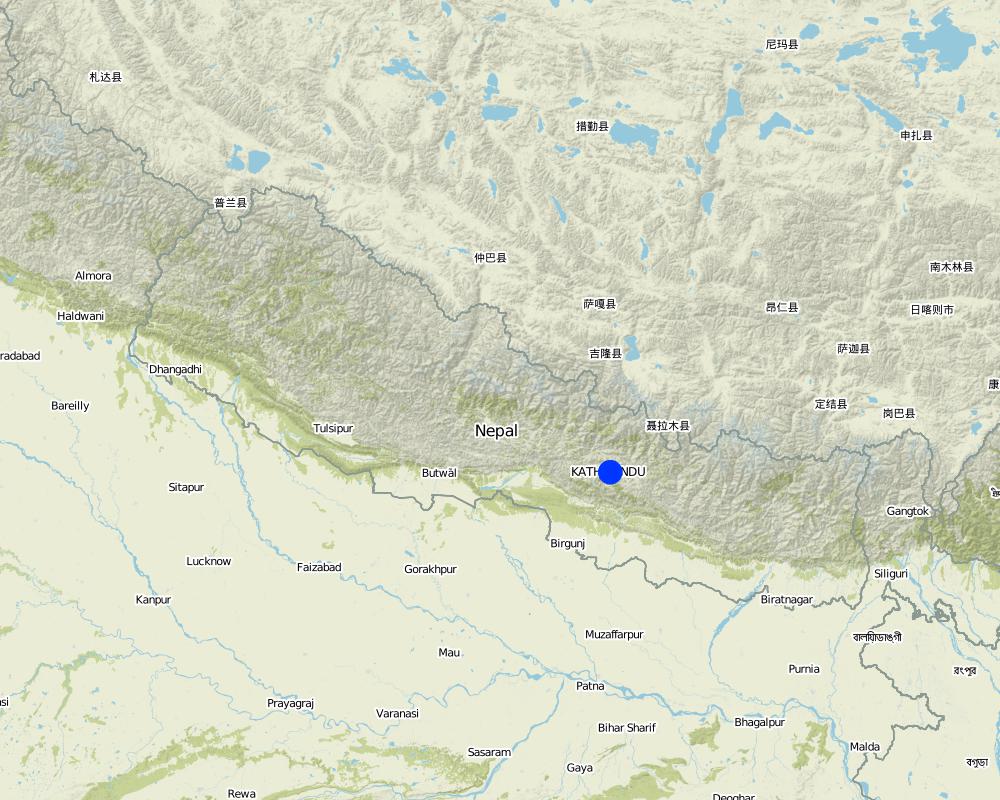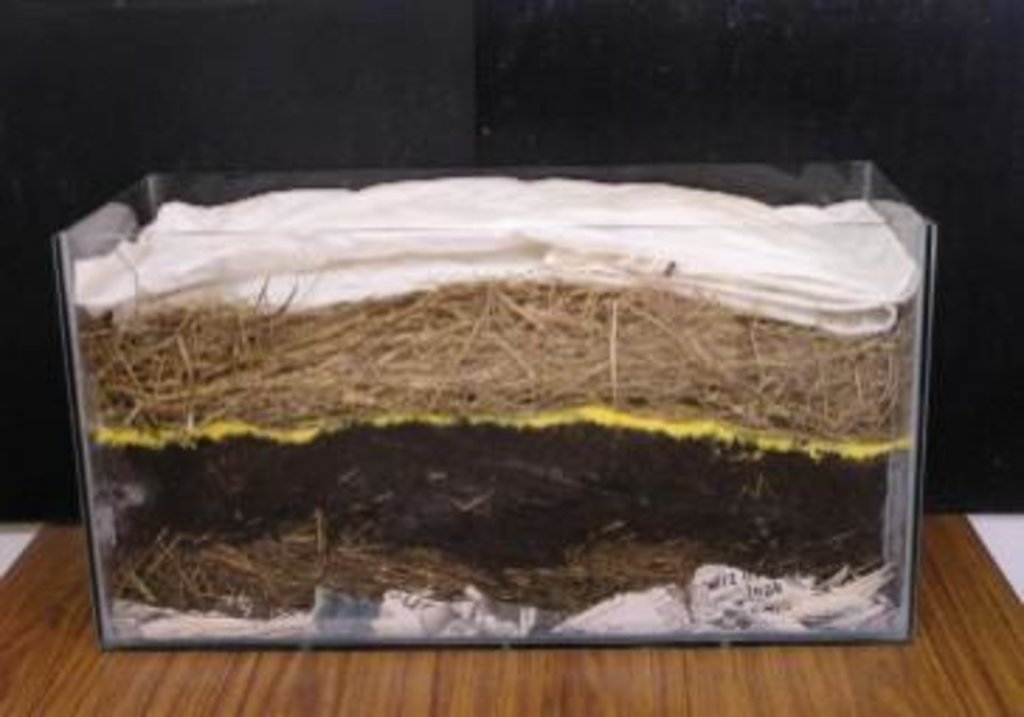Vermi compost technology [Nepal]
- Creation:
- Update:
- Compiler: Sabita Aryal
- Editor: –
- Reviewers: David Streiff, Alexandra Gavilano
technologies_1236 - Nepal
View sections
Expand all Collapse all1. General information
1.2 Contact details of resource persons and institutions involved in the assessment and documentation of the Technology
SLM specialist:
Pandey Anagha
Kathmandu University
Nepal
SLM specialist:
Shrestha Prasanna
Kathmandu University
Nepal
SLM specialist:
Maharjan Sanu
Kathmandu, metropolitan Teku
Nepal
Name of the institution(s) which facilitated the documentation/ evaluation of the Technology (if relevant)
Kathmandu University (KU) - Nepal1.3 Conditions regarding the use of data documented through WOCAT
The compiler and key resource person(s) accept the conditions regarding the use of data documented through WOCAT:
Yes
1.4 Declaration on sustainability of the described Technology
Is the Technology described here problematic with regard to land degradation, so that it cannot be declared a sustainable land management technology?
No
2. Description of the SLM Technology
2.1 Short description of the Technology
Definition of the Technology:
Technology for converting biodegradable waste into organic manure with the help of earthworms
2.2 Detailed description of the Technology
Description:
Vermicomposting or worm composting is a simple technique that is used to convert the biodegradable waste into organic manure with the help of earthworms or other worms. Great care should be given in the process, since it is prepared by earthworm and are very sensitive to the external environment. The compost prepared after vermicomposting may be much beneficial as a fertilizer. It has low capital cost and operating cost. It provides excellent employment, beside the best technology it is eco friendly.
Purpose of the Technology: This technology is mainly focused on management of 64% of organic waste produced everyday. It has contributed in vegetative waste management.
Establishment / maintenance activities and inputs: The establishment of this technology was taken into consideration after many researches a decade ago. Once the set up is made to perform a vermi culture the maintenance in 3-4 months in necessary. But the maintenance is not difficult as it can be done in a very small space.
Natural / human environment: For this culture to go on smoothly there exists some natural conditions. The moisture contents should be maintained in the vessel in addition to temperature not more than 28-32°C.
In addition the vermi composting should also be given adequate safety by human. The domestic animals and other should be kept far away from the area of composing because they would harm earthworm which plays te most important role in composting. The vessel shouldn't be more than 2 ft in height.
2.3 Photos of the Technology
2.5 Country/ region/ locations where the Technology has been applied and which are covered by this assessment
Country:
Nepal
Region/ State/ Province:
Nepal
Further specification of location:
Kathmandu, Lalitpur, Biratnagar, etc
Specify the spread of the Technology:
- evenly spread over an area
If precise area is not known, indicate approximate area covered:
- > 10,000 km2
Comments:
No actual data has been recorded till date related to SLM approach area. It can be practised in small area to large area. There is not any commercial background in Nepal so its indefinite. It's wide spread all over.
Map
×2.6 Date of implementation
If precise year is not known, indicate approximate date:
- more than 50 years ago (traditional)
2.7 Introduction of the Technology
Specify how the Technology was introduced:
- as part of a traditional system (> 50 years)
3. Classification of the SLM Technology
3.1 Main purpose(s) of the Technology
- access to fertilizer
3.2 Current land use type(s) where the Technology is applied

Cropland
- Annual cropping
- Perennial (non-woody) cropping
Annual cropping - Specify crops:
- cereals - maize
- root/tuber crops - potatoes
- vegetables - leafy vegetables (salads, cabbage, spinach, other)
- rice
Comments:
major cash crop: Rice and potato
major food crop: Maize and cauliflower
Major land use problems (compiler’s opinion): - mixed household waste
- difficulty in separation of organic and inorganic waste.
-pollution created due to waste (vegetative and agricultural)
Major land use problems (land users’ perception): -crop productivity is limited by poor soil fertility
-intense cropping, and a scarcity of irrigation water
-decrease in the health of their crops and degraded soil conditions when chemical fertilizers are overused
3.4 Water supply
Water supply for the land on which the Technology is applied:
- mixed rainfed-irrigated
3.5 SLM group to which the Technology belongs
- integrated soil fertility management
- beekeeping, aquaculture, poultry, rabbit farming, silkworm farming, etc.
3.6 SLM measures comprising the Technology

agronomic measures
- A1: Vegetation/ soil cover

vegetative measures
- V1: Tree and shrub cover
- V2: Grasses and perennial herbaceous plants

structural measures
- S4: Level ditches, pits
- S11: Others

management measures
- M1: Change of land use type
- M4: Major change in timing of activities
3.7 Main types of land degradation addressed by the Technology

chemical soil deterioration
- Cn: fertility decline and reduced organic matter content (not caused by erosion)
- Cp: soil pollution

biological degradation
- Bl: loss of soil life
Comments:
Main causes of degradation: industrial activities and mining, Heavy / extreme rainfall (intensity/amounts) (it cause erosion of top soil), population pressure
Secondary causes of degradation: soil management, crop management (annual, perennial, tree/shrub), change in temperature (denaturation of nutrients), inputs and infrastructure: (roads, markets, distribution of water points, other, …), governance / institutional
3.8 Prevention, reduction, or restoration of land degradation
Specify the goal of the Technology with regard to land degradation:
- prevent land degradation
4. Technical specifications, implementation activities, inputs, and costs
4.1 Technical drawing of the Technology
Technical specifications (related to technical drawing):
Firstly, the wastes are segregated and is arranged in a container. the base of the container i.e the bedding may be done using straw or paper. The layer above it is the soil layer. Next, the earthworm layer followed by the organic waste. the container is closed with a lid with holes in it. After certain time interval the manure prepared is arranged .
Later, the earthworms are separated from the compost formed.
Kathmandu
Technical knowledge required for field staff / advisors: low
Technical knowledge required for land users: low (indigenous knowledge)
Main technical functions: increase in organic matter
Secondary technical functions: increase in nutrient availability (supply, recycling,…), increase of infiltration
Aligned: -along boundary
Vegetative material: T : trees / shrubs
Number of plants per (ha): 4.3 tonnes/ha
Vertical interval between rows / strips / blocks (m): 0.3
Vertical interval within rows / strips / blocks (m): 0.1
Structural measure: container
Width of bunds/banks/others (m): 0.6096
Length of bunds/banks/others (m): 2.4384
Construction material (earth): mud can be used as base or it is also used in the container made of other materials.
Construction material (concrete): a container is necessary
Author:
Teku
4.2 General information regarding the calculation of inputs and costs
Specify currency used for cost calculations:
- USD
4.3 Establishment activities
| Activity | Timing (season) | |
|---|---|---|
| 1. | container with lid | |
| 2. | earthworm | |
| 3. | straw, paper or cloth |
4.4 Costs and inputs needed for establishment
| Specify input | Unit | Quantity | Costs per Unit | Total costs per input | % of costs borne by land users | |
|---|---|---|---|---|---|---|
| Equipment | Container with lid | pieces | 1.0 | 62.5 | 62.5 | |
| Equipment | Earthworm | worms | 625.0 | 0.02 | 12.5 | |
| Equipment | Straw, paper or cloth | kg | 2.0 | 0.9 | 1.8 | |
| Total costs for establishment of the Technology | 76.8 | |||||
| Total costs for establishment of the Technology in USD | 76.8 | |||||
4.5 Maintenance/ recurrent activities
| Activity | Timing/ frequency | |
|---|---|---|
| 1. | moisture maintenance | once a day |
| 2. | hatching | once in 3-4 months |
| 3. | vegetative waste | added everyday for 1-2 months |
4.6 Costs and inputs needed for maintenance/ recurrent activities (per year)
| Specify input | Unit | Quantity | Costs per Unit | Total costs per input | % of costs borne by land users | |
|---|---|---|---|---|---|---|
| Labour | Moisture maintenance | persons/month | 1.0 | 1.5 | 1.5 | |
| Labour | Hatching | persons/3 month | 1.0 | 1.5 | 1.5 | |
| Equipment | Vegetative waste | kg | 2.0 | |||
| Total costs for maintenance of the Technology | 3.0 | |||||
| Total costs for maintenance of the Technology in USD | 3.0 | |||||
Comments:
Costs calculated on the basis of earthworms used and some of the tools used.
The container used in Kathmandu metropolitan, Teku is of measurement 2.4384 m in length and 0.6096 m in width which gives about 500 kg of compost after few months.
4.7 Most important factors affecting the costs
Describe the most determinate factors affecting the costs:
The number of earthworm used for composting affect the cost.
5. Natural and human environment
5.2 Topography
Slopes on average:
- flat (0-2%)
- gentle (3-5%)
- moderate (6-10%)
- rolling (11-15%)
- hilly (16-30%)
- steep (31-60%)
- very steep (>60%)
Landforms:
- plateau/plains
- ridges
- mountain slopes
- hill slopes
- footslopes
- valley floors
Altitudinal zone:
- 0-100 m a.s.l.
- 101-500 m a.s.l.
- 501-1,000 m a.s.l.
- 1,001-1,500 m a.s.l.
- 1,501-2,000 m a.s.l.
- 2,001-2,500 m a.s.l.
- 2,501-3,000 m a.s.l.
- 3,001-4,000 m a.s.l.
- > 4,000 m a.s.l.
5.3 Soils
Soil depth on average:
- very shallow (0-20 cm)
- shallow (21-50 cm)
- moderately deep (51-80 cm)
- deep (81-120 cm)
- very deep (> 120 cm)
Topsoil organic matter:
- high (>3%)
If available, attach full soil description or specify the available information, e.g. soil type, soil PH/ acidity, Cation Exchange Capacity, nitrogen, salinity etc.
Soil fertility is very high
Soil drainage / infiltration is good
Soil water storage capacity is medium
5.6 Characteristics of land users applying the Technology
Market orientation of production system:
- mixed (subsistence/ commercial)
Off-farm income:
- 10-50% of all income
Relative level of wealth:
- poor
- average
Individuals or groups:
- groups/ community
Level of mechanization:
- manual work
- mechanized/ motorized
Gender:
- women
- men
Indicate other relevant characteristics of the land users:
Land users applying the Technology are mainly common / average land users
Population density: 100-200 persons/km2
10% of the land users are rich.
60% of the land users are average wealthy.
30% of the land users are poor.
Level of mechanization: Tractor use.
5.7 Average area of land used by land users applying the Technology
- < 0.5 ha
- 0.5-1 ha
- 1-2 ha
- 2-5 ha
- 5-15 ha
- 15-50 ha
- 50-100 ha
- 100-500 ha
- 500-1,000 ha
- 1,000-10,000 ha
- > 10,000 ha
Is this considered small-, medium- or large-scale (referring to local context)?
- small-scale
5.8 Land ownership, land use rights, and water use rights
Land ownership:
- group
- individual, not titled
- government
Land use rights:
- communal (organized)
- individual
Water use rights:
- open access (unorganized)
- communal (organized)
Comments:
land and water resources are used fro communal property
5.9 Access to services and infrastructure
health:
- poor
- moderate
- good
education:
- poor
- moderate
- good
technical assistance:
- poor
- moderate
- good
employment (e.g. off-farm):
- poor
- moderate
- good
markets:
- poor
- moderate
- good
energy:
- poor
- moderate
- good
roads and transport:
- poor
- moderate
- good
drinking water and sanitation:
- poor
- moderate
- good
financial services:
- poor
- moderate
- good
6. Impacts and concluding statements
6.1 On-site impacts the Technology has shown
Socio-economic impacts
Production
crop production
fodder production
fodder quality
wood production
product diversity
land management
Income and costs
farm income
workload
Comments/ specify:
Time consuming
Socio-cultural impacts
food security/ self-sufficiency
health situation
SLM/ land degradation knowledge
situation of socially and economically disadvantaged groups
livelihood and human well-being
Comments/ specify:
It has taught people to manage 64% of the household waste. - the product from this technology is much efficient in the agriculture. - this can be taken into commercial level. - the solid waste management problem is reduced to minimum on adoption of this technology.
Production of smell
Ecological impacts
Water cycle/ runoff
evaporation
Soil
soil moisture
soil cover
soil compaction
nutrient cycling/ recharge
soil organic matter/ below ground C
Biodiversity: vegetation, animals
beneficial species
6.2 Off-site impacts the Technology has shown
groundwater/ river pollution
6.3 Exposure and sensitivity of the Technology to gradual climate change and climate-related extremes/ disasters (as perceived by land users)
Gradual climate change
Gradual climate change
| Season | increase or decrease | How does the Technology cope with it? | |
|---|---|---|---|
| annual temperature | increase | well |
Climate-related extremes (disasters)
Meteorological disasters
| How does the Technology cope with it? | |
|---|---|
| local rainstorm | well |
Climatological disasters
| How does the Technology cope with it? | |
|---|---|
| drought | not well |
Comments:
- more variety of earthworm.
- new design for the base formation.
6.4 Cost-benefit analysis
How do the benefits compare with the establishment costs (from land users’ perspective)?
Short-term returns:
positive
Long-term returns:
positive
How do the benefits compare with the maintenance/ recurrent costs (from land users' perspective)?
Short-term returns:
slightly positive
Long-term returns:
slightly positive
Comments:
The vermi composting has many benefits compared to harms and is very economical in any way.
6.5 Adoption of the Technology
Comments:
There is a little trend towards spontaneous adoption of the Technology
6.7 Strengths/ advantages/ opportunities of the Technology
| Strengths/ advantages/ opportunities in the compiler’s or other key resource person’s view |
|---|
| Management of solid waste, reduces cost of waste management. |
| utilization of organic waste. |
| helps to generate income. |
| very economical and gives best manure for food crops. |
| no much labour. |
6.8 Weaknesses/ disadvantages/ risks of the Technology and ways of overcoming them
| Weaknesses/ disadvantages/ risks in the compiler’s or other key resource person’s view | How can they be overcome? |
|---|---|
| Vermi culture is not wide spread even within a community. | Awareness to a high priority is required. |
| No segregation from household level. | Governmental efforts should be given priority. |
| No sufficient market. | Priority from all the sectors is important. |
| Process can be quicker only in the presence of more labour. | Different technical support can help to make it quicker. |
| Vulnerable to environment pressure such as temp, drought, etc. | Regular maintenance is required. |
7. References and links
7.1 Methods/ sources of information
- field visits, field surveys
- interviews with land users
7.2 References to available publications
Title, author, year, ISBN:
Technical manuals:Community mobilization unitKathmandu Metropolitan
Available from where? Costs?
Teku, Kathmandu
Links and modules
Expand all Collapse allLinks
No links
Modules
No modules





